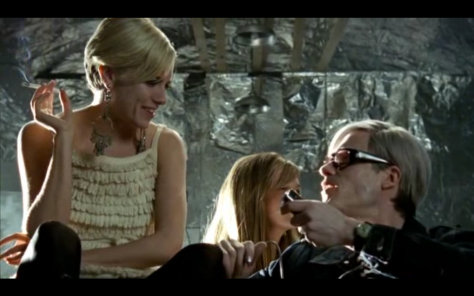By Dennis Hartley
(Originally posted on Digby’s Hullabaloo on October 18, 2008)

Two of America’s finest actors.
No one has ever accused Oliver Stone of being subtle. However, once audiences view his highly anticipated film concerning the life and times of George W. Bush, I think the popular perception about the director, which is that he is a rabid conspiracy theorist who rewrites history via Grand Guignol-fueled cinematic polemics, could begin to diminish. I’m even going to go out on a limb here (gulp!) and call W a fairly straightforward biopic.
Stone intersperses highlights of Bush’s White House years with episodic flashbacks and flash forwards, beginning in the late 60s (when Junior was attending Yale) and taking us up to the present day. I don’t think a full plot summary is necessary; if you are a regular Hullabaloo reader, you know the story all too well: Alcoholic son of Texas oil millionaire stumbles through early adulthood, gets into Yale (eventually Harvard) through the back door, marries a librarian, then discovers his Special Purpose after helping Poppy become President.
Thanks to the savvy guidance of a homunculus sidekick he dubs as “Turdblossom”, he is elected as the governor of Texas (twice) and then finds God, who informs him personally that he is destined to become President, because He has a Special Mission for him. Turns out that his Special Mission is to fight the Evil Doers where they live, after they stage a terrorist attack on America. Trouble is, there seems to be some confusion as to exactly where they live. In the meantime, he’ll need to bitch slap that Bill of Rights (just a little), for our protection.

Best supporting performance?
I’m not saying that Stone doesn’t take a point of view; he wouldn’t be Oliver Stone if he didn’t. He’s already catching flak for the screen time spent dwelling on Bush’s battle with the bottle (the manufacturers of Jack Daniels must have laid out serious bucks for the ubiquitous product placement ). Bush’s history of boozing is a matter of record.
Some are taking umbrage at another one of the chief underlying themes of Stanley Weisner’s screenplay, which is that Bush’s angst (and the drive to succeed at all costs) is propelled by an unrequited desire to please a perennially disapproving George Senior. I’m no psychologist, but that sounds reasonable to me.

Live, from New York…it’s Saturday Night!
As usual, Stone has assembled a massive cast with a bazillion speaking parts. His choice of Josh Brolin for the lead initially struck many people as an odd selection (including yours truly), but now that I have seen the film, I have to say it was a smart move.
Brolin is nothing short of brilliant. He doesn’t go for a cartoon caricature, which would have been the easy route to take; I think he pulls off a Daniel Day Lewis-worthy “total immersion” quite successfully. It is interesting to note that Brolin (tangential to Junior) has been accused of riding into a Hollywood career on the coattails of his dad (James Brolin) and stepmother (Barbara Streisand); if Stone chose his leading man with this in mind, he is a very canny operator.
Some of the other standouts in the cast include Toby Jones as Karl Rove, James Cromwell and the great Ellen Burstyn as President and Mrs. Bush Sr., Jeffrey Wright as Colin Powell and Richard Dreyfuss as Dick Cheney. Wright and Dreyfuss play off each other beautifully while recreating Cheney and Powell’s tiffs. Scott Glenn isn’t given an awful lot to do as Donald Rumsfeld, but he has the evil squint down.
The only casting misfire is an overly mannered Thandie Newton as Condoleezza Rice; it is like she dropped in from an SNL sketch. Perhaps it is not entirely her fault, as there’s so much prosthetic on her face, she can barely move her lips.
Perhaps I should qualify something. When I called this a “straightforward” biopic, I was speaking in relative terms. You have to keep in mind that in one respect, Stone is boldly going where no filmmaker has gone before. PT 109 aside, this is the only biopic about a president to be released while he is still sitting in the Oval Office; and since the former film dealt with JFK’s WW2 exploits, and not his actual presidency, that makes Stone’s film even more unique.
Another hurdle is the fact that the Bush administration has probably been satirized, parodied and ridiculed (via print, blogosphere, TV, film, theater, comedy club, YouTube, T-shirt, billboard, and water cooler chat) more than any other presidency in my lifetime (not that they haven’t asked for it in every way imaginable). This zeitgeist makes it virtually impossible for someone to make a “serious” biopic about W. By playing it straight, Stone is really being subversive (clever boy!).
If the Bush administration had never really happened, and this was a completely fictional creation, I would be describing Stone’s film by throwing out one-sheet ready superlatives like “A wildly imaginative look at the dark side of the American Dream!” or “A vivid, savage satire for our times!” But you see, when it comes to the life and legacy of one George W. Bush and the Strangelovian nightmare that he and his cohorts have plunged this once great nation into for the last eight years, all you have to do is tell the truth…and pass the popcorn.






